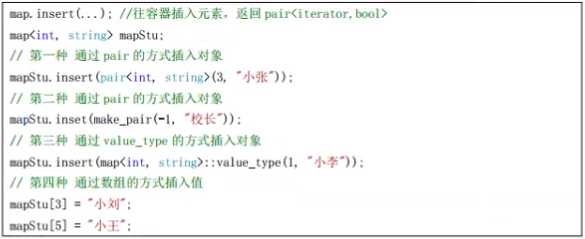map/multimap
一、map/multimap特性
map相对于set的区别,map具有键值和实值,所有元素根据键值自动排序,pair的第一元素被称为键值,第二元素被称为实值。map也是以红黑树为底层实现机制。
问:通过map的迭代器可以修改map的键值吗?
答:不能,键值关系到容器内元素的排序规则,任意改变键值会破坏容器的排列规则,但是可以改变实值。
map和multimap区别在于,map不允许相同key值存在,multimap则允许相同key值存在。
二、map常用API
1、map构造函数

2、map赋值操作

3、map大小操作

4、map插入数据元素操作

注意:
-
前三种方法,采用的是insert()方法,该方法返回值为pair<iterator,bool>
-
第四种方法非常直观,但存在一个性能的问题。插入3时,先在mapStu中查找主键为3的项,若没发现,则将一个键为3,值为初始化值的对组插入到mapStu中,然后再将值修改为“小刘”。若发现已存在3这个键,则修改这个键对应的value。
-
string strName = mapStu[2];//取操作或插入操作
只有当mapStu存在2这个键时才是正确的取操作,否则会自动插入一个实例,键为2,值为初始化值。
5、map删除操作

6、map查找操作

三、案例
#define _CRT_SECURE_NO_WARNINGS #include <iostream> #include <map> using namespace std; //map容器初始化 void test01() { //map容器模板参数,第一个参数 key的类型,第二个参数 value的类型 map<int,int> mymap; //插入参数 pair.first:key值, pair.second:value值 //方法一 pair<map<int, int>::iterator, bool> ret = mymap.insert(pair<int, int>(10, 10)); if (ret.second) { cout << "第一次插入成功!" << endl; } else { cout << "插入失败!" << endl; } ret = mymap.insert(pair<int, int>(10, 20)); if (ret.second) { cout << "第二次插入成功!" << endl; } else { cout << "插入失败!" << endl; } //第一次插入成功! //插入失败! //如果插入已存在相同键值的pair,则插入失败 //方法二 mymap.insert(make_pair(20, 20)); //方法三 mymap.insert(map<int, int>::value_type(30, 30)); //方法四 mymap[40] = 40; mymap[10] = 20; mymap[50] = 50; /*key: 10 value : 20 key : 20 value : 20 key : 30 value : 30 key : 40 value : 40 key : 50 value : 50*/ //如果key不存在,创建pair插入到map容器中; //如果发现key存在,那么会修改key对应的value //打印 for (map<int, int>::iterator it = mymap.begin();it != mymap.end();it++) { //*it取出来的是第一个pair cout << "key:" << (*it).first << " value:" << it->second << endl; } cout << "mymap[60]:" << mymap[60] << endl; // mymap[60] : 0 for (map<int, int>::iterator it = mymap.begin();it != mymap.end();it++) { //*it取出来的是第一个pair cout << "key:" << (*it).first << " value:" << it->second << endl; } /*key : 10 value : 20 key : 20 value : 20 key : 30 value : 30 key : 40 value : 40 key : 50 value : 50 key : 60 value : 0*/ //如果通过[]方式去访问map中一个不存在的key, //那么map会将这个访问的key插入到map中,并且给value一个默认值 } class MyKey { public: MyKey(int index, int id) { this->mIndex = index; this->mID = id; } public: int mIndex; int mID; }; struct mycompare { bool operator()(MyKey key1, MyKey key2) { return key1.mIndex < key2.mIndex; } }; void test02() { map<MyKey, int, mycompare> mymap;//自动排序,自定义数据类型,需自行设置排序规则 mymap.insert(make_pair(MyKey(1, 2), 10)); mymap.insert(make_pair(MyKey(4, 5), 20)); for (map<MyKey, int, mycompare>::iterator it = mymap.begin();it != mymap.end();it++) { cout << it->first.mIndex << ":" << it->first.mID << "=" << it->second << endl; } } void test03() { map<int, int> mymap; mymap.insert(make_pair(1, 4)); mymap.insert(make_pair(2, 5)); mymap.insert(make_pair(3, 6)); pair<map<int, int>::iterator, map<int, int>::iterator> ret = mymap.equal_range(2); if (ret.first->second) { cout << "找到lower_bound!" << endl; } else { cout << "没有找到!"; } if (ret.second->second) { cout << "找到upper_bound!" << endl; } else { cout << "没有找到!"; } } int main(void) { //test01();//前三种方法效果是一样的,与第四种不同 //test02(); test03(); return 0; }



